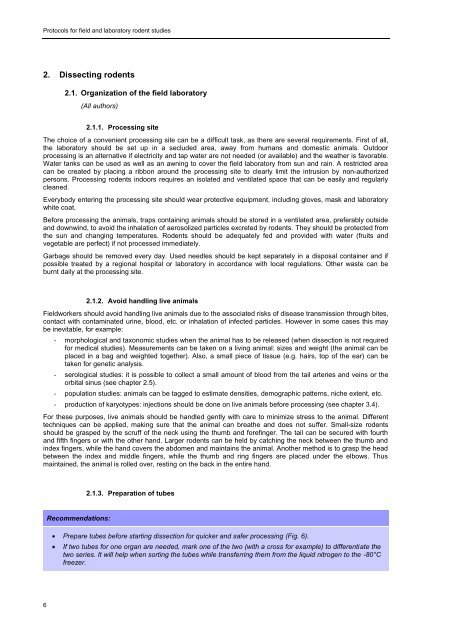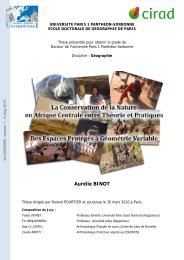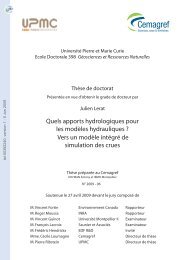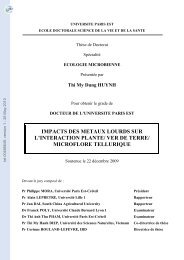Protocols for field and laboratory rodent studies - HAL
Protocols for field and laboratory rodent studies - HAL
Protocols for field and laboratory rodent studies - HAL
- No tags were found...
You also want an ePaper? Increase the reach of your titles
YUMPU automatically turns print PDFs into web optimized ePapers that Google loves.
<strong>Protocols</strong> <strong>for</strong> <strong>field</strong> <strong>and</strong> <strong>laboratory</strong> <strong>rodent</strong> <strong>studies</strong>2. Dissecting <strong>rodent</strong>s2.1. Organization of the <strong>field</strong> <strong>laboratory</strong>(All authors)2.1.1. Processing siteThe choice of a convenient processing site can be a difficult task, as there are several requirements. First of all,the <strong>laboratory</strong> should be set up in a secluded area, away from humans <strong>and</strong> domestic animals. Outdoorprocessing is an alternative if electricity <strong>and</strong> tap water are not needed (or available) <strong>and</strong> the weather is favorable.Water tanks can be used as well as an awning to cover the <strong>field</strong> <strong>laboratory</strong> from sun <strong>and</strong> rain. A restricted areacan be created by placing a ribbon around the processing site to clearly limit the intrusion by non-authorizedpersons. Processing <strong>rodent</strong>s indoors requires an isolated <strong>and</strong> ventilated space that can be easily <strong>and</strong> regularlycleaned.Everybody entering the processing site should wear protective equipment, including gloves, mask <strong>and</strong> <strong>laboratory</strong>white coat.Be<strong>for</strong>e processing the animals, traps containing animals should be stored in a ventilated area, preferably outside<strong>and</strong> downwind, to avoid the inhalation of aerosolized particles excreted by <strong>rodent</strong>s. They should be protected fromthe sun <strong>and</strong> changing temperatures. Rodents should be adequately fed <strong>and</strong> provided with water (fruits <strong>and</strong>vegetable are perfect) if not processed immediately.Garbage should be removed every day. Used needles should be kept separately in a disposal container <strong>and</strong> ifpossible treated by a regional hospital or <strong>laboratory</strong> in accordance with local regulations. Other waste can beburnt daily at the processing site.2.1.2. Avoid h<strong>and</strong>ling live animalsFieldworkers should avoid h<strong>and</strong>ling live animals due to the associated risks of disease transmission through bites,contact with contaminated urine, blood, etc. or inhalation of infected particles. However in some cases this maybe inevitable, <strong>for</strong> example:- morphological <strong>and</strong> taxonomic <strong>studies</strong> when the animal has to be released (when dissection is not required<strong>for</strong> medical <strong>studies</strong>). Measurements can be taken on a living animal: sizes <strong>and</strong> weight (the animal can beplaced in a bag <strong>and</strong> weighted together). Also, a small piece of tissue (e.g. hairs, top of the ear) can betaken <strong>for</strong> genetic analysis.- serological <strong>studies</strong>: it is possible to collect a small amount of blood from the tail arteries <strong>and</strong> veins or theorbital sinus (see chapter 2.5).- population <strong>studies</strong>: animals can be tagged to estimate densities, demographic patterns, niche extent, etc.- production of karyotypes: injections should be done on live animals be<strong>for</strong>e processing (see chapter 3.4).For these purposes, live animals should be h<strong>and</strong>led gently with care to minimize stress to the animal. Differenttechniques can be applied, making sure that the animal can breathe <strong>and</strong> does not suffer. Small-size <strong>rodent</strong>sshould be grasped by the scruff of the neck using the thumb <strong>and</strong> <strong>for</strong>efinger. The tail can be secured with fourth<strong>and</strong> fifth fingers or with the other h<strong>and</strong>. Larger <strong>rodent</strong>s can be held by catching the neck between the thumb <strong>and</strong>index fingers, while the h<strong>and</strong> covers the abdomen <strong>and</strong> maintains the animal. Another method is to grasp the headbetween the index <strong>and</strong> middle fingers, while the thumb <strong>and</strong> ring fingers are placed under the elbows. Thusmaintained, the animal is rolled over, resting on the back in the entire h<strong>and</strong>.2.1.3. Preparation of tubesRecommendations:Prepare tubes be<strong>for</strong>e starting dissection <strong>for</strong> quicker <strong>and</strong> safer processing (Fig. 6).If two tubes <strong>for</strong> one organ are needed, mark one of the two (with a cross <strong>for</strong> example) to differentiate thetwo series. It will help when sorting the tubes while transferring them from the liquid nitrogen to the -80°Cfreezer.6
















